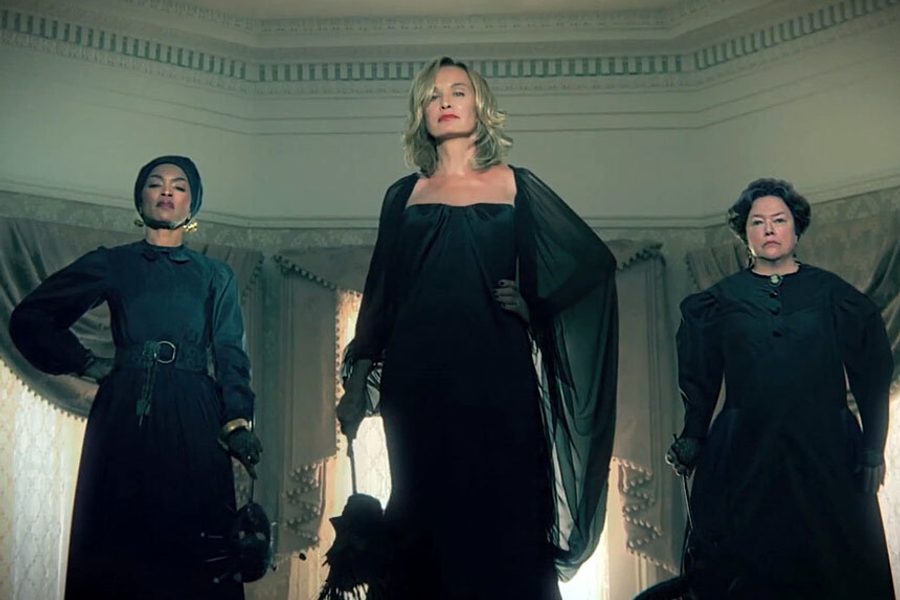Double, Double, Race and Gender Trouble
American Horror Story: Coven sets out to explore race, but doesn’t get past white guilt.
Jude Ellison Sady Doyle

It feels a little uncomfortable taking American Horror Story: Coven seriously. The tone the hit FX series aims for is high camp: artfully artificial, painstakingly trashy, seriously un-serious. It’s the sort of show where Frances Conroy swans about dressed like Grace Coddington, gouging her enemies’ eyes out with a melon baller while hissing, “Your fashion faux pas give me nightmares!” The sort of show where two teenage girls create a “perfect boyfriend” by sewing together and reanimating dismembered corpses, and then decide to have a three-way with him. The sort of show where Academy-Award-winning actress Kathy Bates plays a racist severed head that is forced to watch Roots.
This is where the problem starts. American Horror Story, you see, is a show with big ambitions. Beneath all the silliness, it really does want to say something about America and its horrors. Season one, American Horror Story: Murder House, was about the disintegration of the nuclear family, as expressed through a house that made people murder each other. The second season, American Horror Story: Asylum, had demons, mutants, aliens and serial killers, but the real horror for its cast of institutionalized deviants — a man in an interracial marriage, a lesbian, a sexual abuse survivor who’d killed her attacker, a “nymphomaniac” whose crime was cheating on her abusive and philandering husband — was the power of oppressive sexual norms to ruin lives. In Coven, the problem being worked out is, apparently, intersectional feminism: Showrunner Ryan Murphy has claimed that this season is “ a meditation on race relations in this country” and also “about female power,” clarifying that the season “really is about the [white] witches of Salem pitted against [black] voodoo witches. It’s been a centuries-long feud and it’s up to Jessica Lange and Angela Bassett to mend the fence.” As might be expected, when you approach a topic this sensitive with a studied commitment to being insensitive, the results are… let us say, uneven. And much of this rests with the troubled, troubling history of Kathy Bates’ severed head.
Help keep this reporting possible by making a donation today.
[SPOILER ALERT: Character details from season three follow.]
Bates, you see, plays Madame LaLaurie — a real historical figure whose New Orleans manor was found to contain a torture chamber where she mutilated and murdered her slaves. In the world of American Horror Story, Madame LaLaurie also used the slaves’ blood to make a special skin-care potion so as to retain her youth and the affections of her husband. This practice earned her the enmity of Marie Laveau (another real woman, a legendary voodoo practitioner reportedly seen around New Orleans years after her death), who cursed LaLaurie with eternal life, then buried her alive.
Nearly 200 years later, Marie Laveau is still alive and looking like Angela Bassett, and “witchcraft” —which, Laveau maintains, originated with black women, including Tituba, who taught it to the Salem witches — has been appropriated by a lineage of wealthy white women, led by Fiona Goode (Jessica Lange). Naturally, the two groups are at war, and it doesn’t help that Goode occasionally pops over to Laveau’s place to scoff at the idea that black women could have originated witchcraft. And yet, though Goode is adamant that black witches can’t teach her anything, she would very much like for Marie Laveau to teach her that whole “eternal life” trick. So, naturally, Goode digs up LaLaurie as a bargaining chip, Laveau is angered by LaLaurie’s escape and lops her head off, LaLaurie can’t die even after her head is cut off, and the end result of all this is that Kathy Bates plays a racist severed head that is forced to watch Roots.
In the abstract, this doesn’t sound so bad. In fact, if you accept the “witchcraft equals feminism” metaphor, it sounds like American Horror Story: #solidarityisforwhitewomen. But the fantasy on display is less about “race relations” or feminism than it is about white guilt — about white people’s uncomfortable relationship with our own history.
Madame LaLaurie may be a racist, slave-owning serial killer who once peeled a man’s face off for her own personal entertainment. But she is also, through Kathy Bates’ portrayal and the show’s writing, one of the most sympathetic characters on the show. She’s been tortured for centuries, freed into a world she doesn’t remotely understand — the show’s biggest laugh, to date, has come from her tearful, horrified reaction to seeing President Obama on the “magic box” — forced to work as a young black woman’s “slave,” become a reluctant yet loyal friend to that young woman, confronted and repented her own inadequacies as a person, and for all that, she’s had her head lopped off and put in front of a TV set.
Some of this seems like revenge fantasy; the other half, given the genuine tenderness in her scenes with Queenie (the young black woman she serves), seems like a story about forgiveness. Granted, LaLaurie suddenly started spouting vicious racist rhetoric again because the plot demanded it (this is American Horror Story, where characters’ motivations rarely remain the same from scene to scene, let alone episode to episode), but, as others have noted, that’s a tremendous amount of narrative work put into redeeming, and making us pity, someone who should be completely irredeemable.
Meanwhile, Marie Laveau has been given two settings: “righteously angry” and “righteously angry while summoning zombies.” Laveau, like LaLaurie, is the voice of history in the narrative: No one needs to remind her about the racism in this country, because she has experienced the racism in this country, pretty much all of it. She’s survived hundreds of years of brutality and degradation, forgetting none of it, forgiving none of it, and avenging it when and where she can. And, at the end of all this work, the white witches swan around in a mansion while Laveau works for a living, running a hair salon. (For this, Goode mocks her: “Maybe in another century, you’ll have two shithole salons.”) There should be a tremendous narrative charge to this character, but for the most part, she pops in for a scene or two every few episodes to scowl at the white women.
The show’s other major character of color, Queenie — the young black witch who befriends LaLaurie, played by no less of an actress than Gabourey Sidibe — gets an even less three-dimensional treatment. Her entire story is about deciding whether she thinks LaLaurie is forgivable. If Marie Laveau is the fact of history, Queenie is the question of whether progress is possible. Whereas Marie Laveau just wants to lop LaLaurie’s head off, Queenie gives the head a speech about how ignorant it is, then makes it watch Roots.
And all of this makes sense, if you consider that LaLaurie is white guilt incarnate. American Horror Story is frequently smarter than it looks, and as metaphors go, this is a pretty great one. [SPOILER ALERT: Details of this week’s episode follow.] In Wednesday’s episode, the two groups of witches face a common threat, an ancient order of all-male “witch-hunters.” Fiona, who’s been taunting Laveau with heavily racialized insults all season long, now comes to her doorstep with appeals to their common womanhood and common vulnerability to patriarchy — er, I mean, witch-hunters: “We need to stop this petty quarreling,” Goode says. “We’ve got bigger problems than what goes on between us.” At this point, Kathy Bates’ severed head squawks out in panic: “You can’t make a deal with a darkie!” And Goode quickly shoves a wadded-up newspaper in its mouth.
LaLaurie is history, privilege, whiteness: She’s ancient, she’s stupid, she’s violent, and worst of all, she just won’t shut up. She’s hundreds of years old, and although she’s smaller than she used to be, she’s not dead yet. In fact, it’s alarmingly possible that she can’t die. If Goode is ever going to be the good white intersectional feminist who makes peace with Marie Laveau, the first thing she has to do is put a gag in that damn head. She’s got to keep Madame LaLaurie from speaking, keep her voice from sabotaging the conversation — even though, to be quite honest, LaLaurie’s voice has been coming out of Goode’s mouth all season long. You can hear it when Goode describes her war with Laveau as “petty quarrelling” — as if what Laveau has endured, over her very long lifetime, has ever been anything like “petty.” Goode sees LaLaurie as the “bad” white woman, and herself as the “good” one — Goode says with no small amount of pride that she voted for Obama — but in fact, the main difference between them is that LaLaurie consciously voices the attitudes that half-consciously inform Fiona’s actions.
The problem is that this deft symbolic work occurs in yet another story “about race” that is actually all about white people’s feelings. At the end of the most recent episode, Marie Laveau sees all of her people — including Queenie — shot to death before her eyes by a white witch-hunter, and it would appear that this occurs solely to motivate the character to team up with Fiona Goode. It’s a scene that presses on real history, real violence, real terror, simply to make the point that Marie Laveau really should be friendlier to the white women. Whether we like it or not, white people are always carrying around LaLaurie’s head. If you listen, you can always hear her speaking. She’s the one that tells you to make the story all about the suffering and redemption of LaLaurie and forgets to write a part in for Queenie.
Jude Ellison Sady Doyle is an In These Times contributing writer. They are the author of Trainwreck: The Women We Love to Hate, Mock, and Fear… and Why (Melville House, 2016) and was the founder of the blog Tiger Beatdown. You can follow them on Twitter at @sadydoyle.









